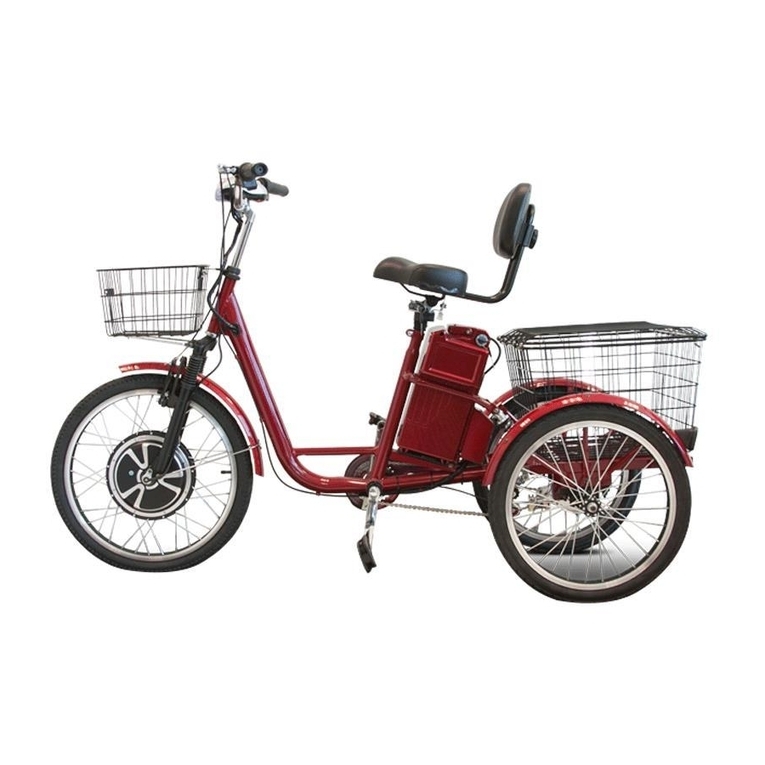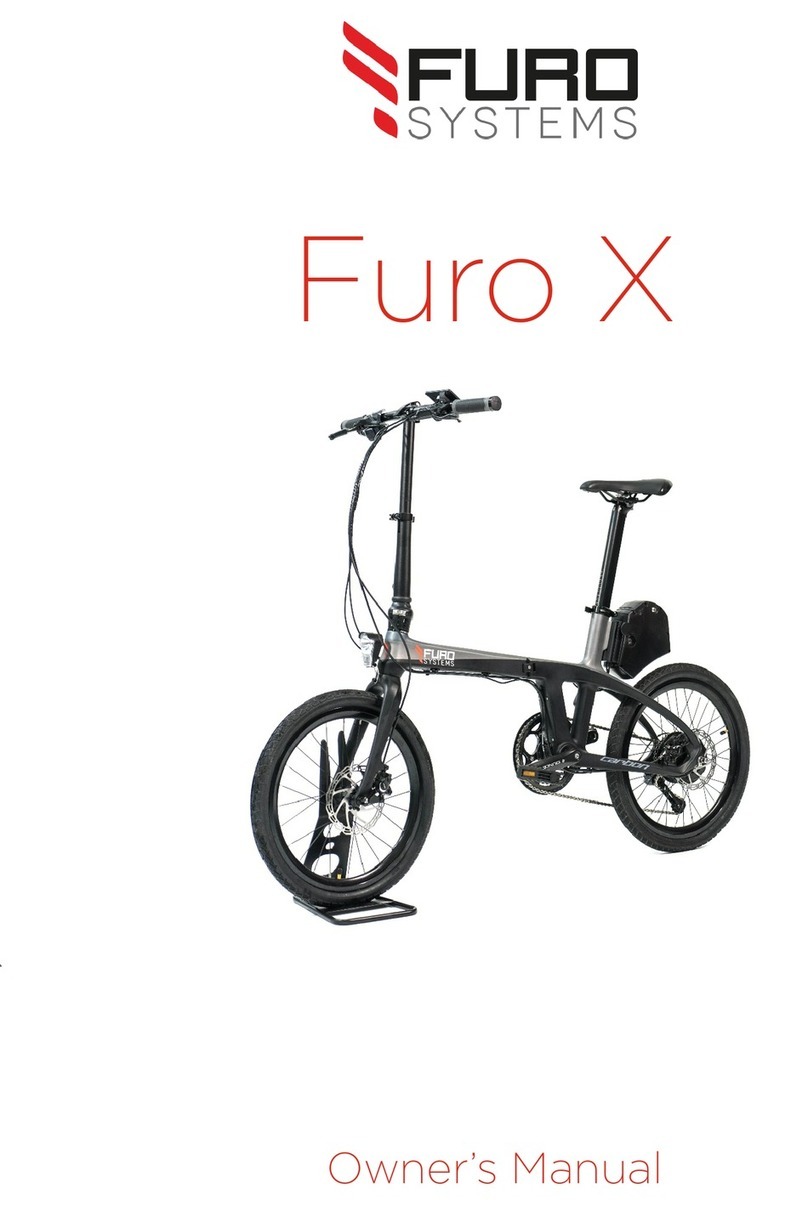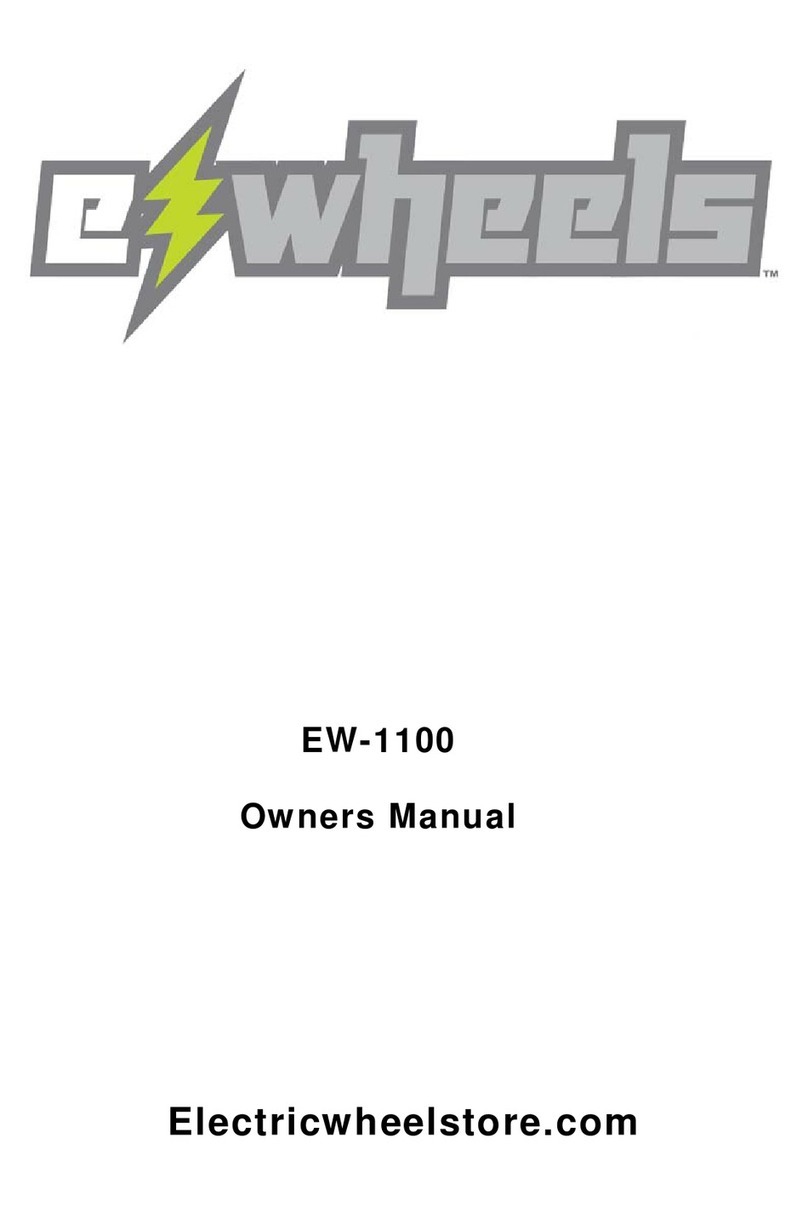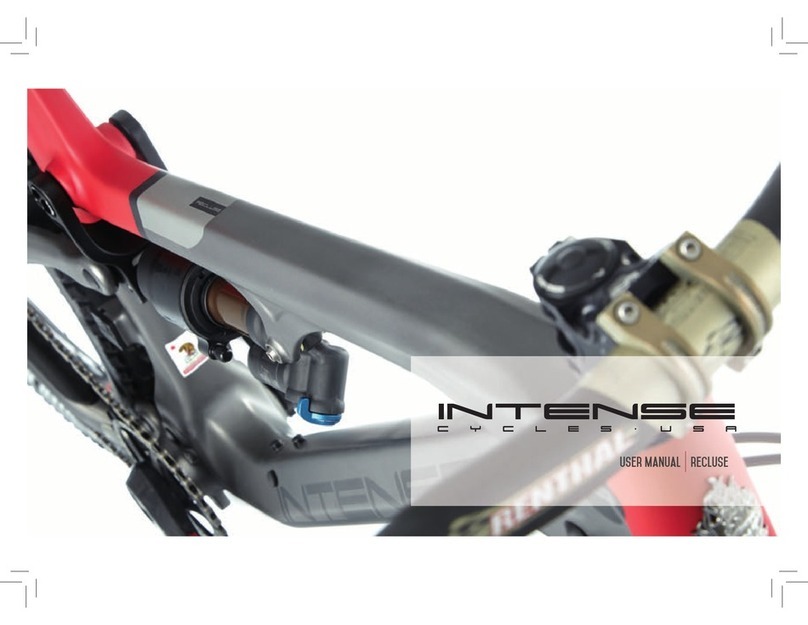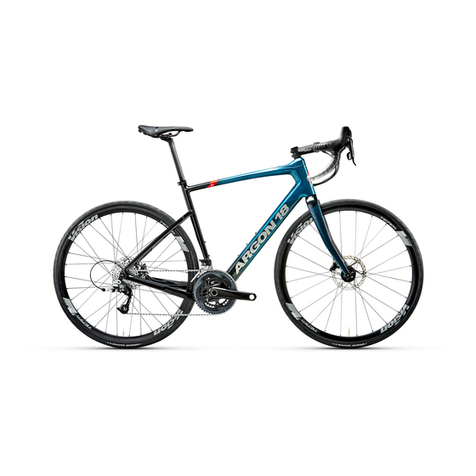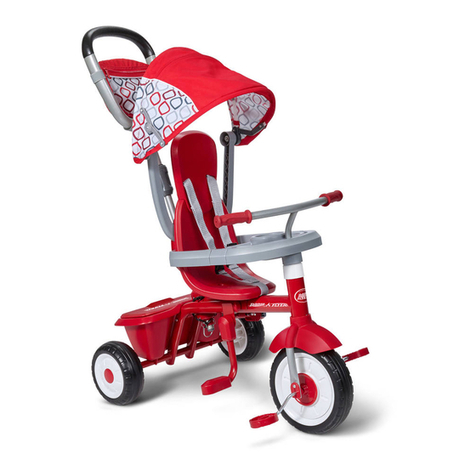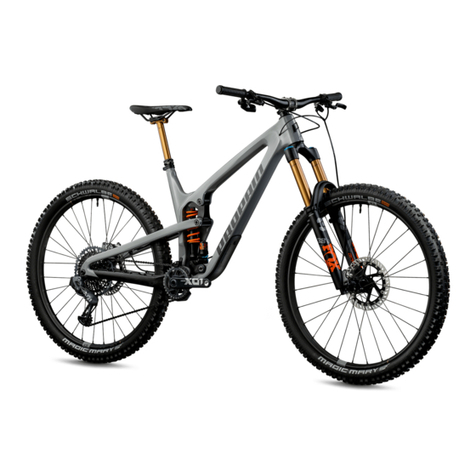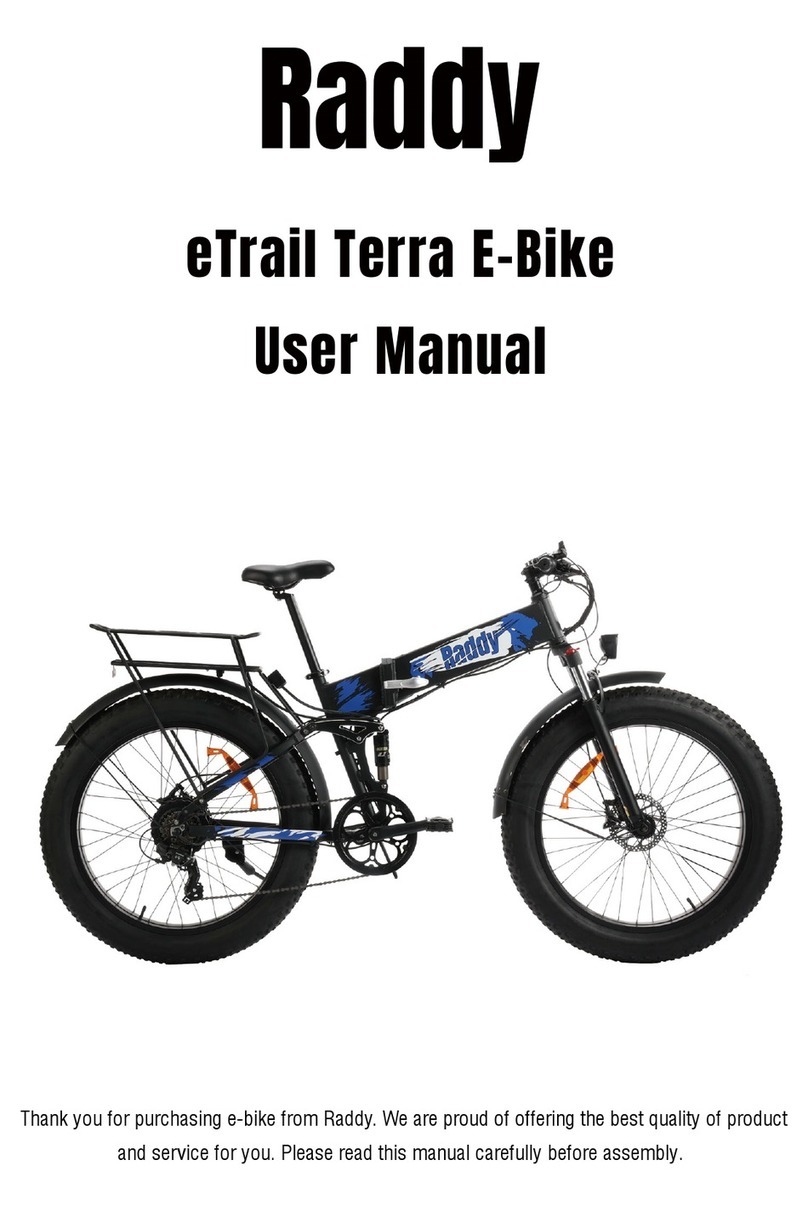StrideCore StrideRide User manual

STRIDECORE
StrideRide Assembly Guide
Our Mission:
Creating fun, exciting, and innovative products
that inspire people to live healthier lives
1

WELCOME, AND CONGRATUALTIONS on your purchase of a new
StrideRide; the fun of Striding around on your new outdoor cardio machine is only
moments away.
Safety First
We strongly encourage you to read through the owner’s manual before you take your
new StrideRide for a spin. By doing so you will have a greater understanding for the
general operation of the various components found on your new ride. Safe riding
instructions are equally important and shouldn’t be overlooked. So even if you are an
experienced cyclist, please take a moment to read through this manual before you ride.
Sharing the Joy of the Ride
Nothing makes us happier than getting outside for some exercise. Our mission is to
create fun exciting, and innovative products that inspire people to live healthier lives. And
it’s this commitment to share the joy of exercise and inspire people to live healthier lives
that we offer the world’s most innovative cardio machine the StrideRide.
2

CONTENTS
Index p.3
General warning p. 4
1. First things First
A. Riders fit p. 5
B. Parental Advisory p. 5
2. Shipping Box Unpack and
Inventory
A. Assembly sequence p. 6
B. Loose part Inventory p. 7
C. Front wheel assembly p.8-10
D. Handle bar assembly p.11-12
E. Pedal cap assembly p.13
3.Fit
A. Handlebar height p. 14
B. Extender tube adjuster handle
alignment feature p.15
C. Brake reach p. 15
D. Mind your head P. 16
E. Riding posture P.16
3
4. Storage and transport
A. Proper Handling & Carrying Procedure p. 17
B. Kick Stand operation p. 18
C. Bike racks see wed site:
http://www.stridecore.com/bike_rack.html
5. Riding Tech
A. Brakes p. 19-21
B. Shifting gears p. 22
C. Tires and Tubes p. 24-25
6. Safety
A. The Basics p. 26-29
B. Mechanical Safety Check p. 30
C. Riding terrain and condition p. 31-32
D. First Ride p. 33
7. Service
A. Service Intervals p. 34-36
8. Warranty
Warranty Information p. 37-38
NOTE: This manual is not intended as a comprehensive use, service, repair or maintenance manual.

GENERAL WARNING:
Like any sport, StrideRiding involves risk of injury and damage. By choosing to ride a
StrideRide, you assume the responsibility for that risk, so you need to know —and to practice
—the rules of safe and responsible riding and of proper use and maintenance. Proper use and
maintenance of your StrideRide reduces risk of injury.
This Manual contains many “Warnings” concerning the consequences of failure to maintain or
inspect your StrideRide and of failure to follow safe cycling practices.
The combination of the safety alert symbol N! and the word WARNING indicates a
potentially hazardous situation which, if not avoided, could result in serious injury or death.
Many of the Warnings say “you may lose control and fall”. Because any fall can result in
serious injury or even death, we do not always repeat the warning of possible injury or death.
The combination of the damage alert symbol I! and the word ALERT calls attention to a
situation which, if not properly addressed or avoided, could cause serious damage to your
StrideRide and/or void your warranty.
Because it is impossible to anticipate every situation or condition which can occur while riding,
this manual makes no representation about the safe use of the StrideRide under all conditions.
There are risks associated with the use of any StrideRide which cannot be predicted or
avoided, and which are the sole responsibility of the rider.
4

1)First things First
NOTE: We strongly urge you to read the Manual in its entirety before your first ride. At the
very least, read and make sure that you understand each point in this section, and refer to
the cited sections on any issue which you don’t completely understand. Ask your dealer to
point out the features of your StrideRide.
Riders fit
StrideRides are designed to:
- Accommodate riders 5'-0" to 6'-4" tall
- Accommodate riders with a minimum weight of 100 lbs
- Accommodate riders with a maximum weight of 230 to 280 lbs (depending on model)
- Accommodate riders over 18 years only (They are NOT designed for children)
- NOT roll backwards (this feature for safer hill starts)
N! WARNING Riders must be at least 5" tall and 100 lbs.
Parental Advisory
The StrideRide is specifically designed to be ridden on paved or dirt roads for exercise by
adults weighing less than 230 pounds on the Standard and Limited models and less than
280 lbs on the Premium and Custom models.
N! WARNING The StrideRide should not be ridden by children at any time. THE
StrideRide DOES NOT MEET SAFETY STANDARDS FOR CHILDREN AND IS NOT INTENDED
FOR USE BY PERSONS LESS THAN 18 YEARS OF AGE. Because the StrideRide lacks many of
the safety features necessary for safe use by children, failure to follow this warning could
result in serious injury or death to your child.
5

StrideSports LLC 6
2) Shipping Box Unpack and Assembly
A. Assembly sequence
1) Unpack box perform inventory
2) Cut handle bar and front wheel shipping zip ties from main assembly
3) Assembly wheel quick release skewer into front wheel p.8
4) Assemble front wheel to main assembly p.9
5) Assemble front handle bar assembly to Extender p.10
6) Assemble stem cap to Extender p.10
7) Place Right and Left hand stride pads onto pedal assembly p.11
8) Screw in the four 5/32” cap screws to secure pads p.12
I! ALERT Do not pick up your StrideRide by its
plastic fender or you void your warranty (Fig #1)
O
P P
P
Fig #1

StrideSports LLC
7
B. Loose Part Inventory
Exam loose parts make sure they are included in packaging:
1) Main bike assembly (not shown)
2) Front wheel assembly (not shown)
3) Front Quick release skewer
4) Stem cap
5) 5mm allen wrench
6) Four cap screws
7) 5/32” allen wrench
8) Left and right pedal pads
3 6
5
4
7
8

StrideSports LLC 8
C. Front wheel assembly
Wheel Quick Release:
N! WARNING: Riding with an improperly adjusted wheel quick release can
allow the wheel to wobble or fall off the StrideRide, which can cause serious
injury or death. Therefore, it is essential that you:
1. Ask your dealer to help you make sure you know how to install and remove
your wheels safely.
2. Understand and apply the correct technique for clamping your wheel in place
with a quick release.
3. Each time, before you StrideRide, check that the wheel is securely clamped.
The wheel quick release uses a cam action to clamp the StrideRide’s wheel in
place (see fig. 2). Because of its adjustable nature, it is critical that you
understand how it works, how to use it properly, and how much force you need
to apply to secure the wheel.

StrideSports LLC 9
Assemble the quick release mechanism to the front wheel:
- Remove the adjusting nut [4] and one spring from the quick release mechanism.
- Put the quick release mechanism [1] through the front wheel hub.
Assemble the front wheel to the fork:
- Put the wheel between the fork legs [3]. Make sure the axle is against the bottom of the
slot in each fork leg.
- Make sure the rotor goes between the brake pads in caliper brake housing.
- Put the spring and adjusting nut [4] back on the quick release mechanism.
- Do not tighten the adjusting nut at this time.
I! ALERT The front fork has a built in wheel retention feature
Adjusting the quick release mechanism:
- The words “open” and “close” are on opposite sides of the quick release lever.
- Move the quick release lever [1] to the “open”position [2] so the word “open” is
pointing away from the wheel.
- Adjust and tighten the quick release mechanism.

StrideSports LLC 10
N! WARNING: Failure to obey these steps can allow the front wheel to loosen while
riding. This can cause injury to the rider or to others.
I! ALERT: Operate the quick release lever by hand only. Do not use a hammer or any
other tool to tighten the quick release lever WARNING: Do not tighten the quick release
mechanism by turning the lever in a circular motion. This causes the clamping force to be
too light.
- You must use strong force to move the quick release lever to the “close” position.
- If you can easily move the lever to the “close” position, the clamping force is too
light.
- If the clamping force of the quick release mechanism is too light, the front wheel
can loosen while riding. This can cause injury to the rider or to others.
- Open and close the quick release lever with one hand while you turn the adjusting
nut with the other hand.
- Tighten or loosen the adjusting nut by hand, so that you first feel resistance to the
quick release lever when it is parallel with the axle.
- Put the wheel in the center of the fork and with strong force, push the cam lever
to the “close” position. When in the “close” position, make sure the quick release
lever lays along the fork.
- Make sure the both the adjusting nut and the opposite end of the quick release
mechanism make marks in the fork.
- If they do not mark the fork, but tighten the adjusting nut tighter than before
- The tightening torque of the quick release lever should be between 43 & 65 in.-lbs.

D. Handle bar assembly
Assemble the handle bar assembly onto the StrideRide:
- Place the stem on top of the extender. (Fig #9)
- Make sure control cables are not twisted. (next page Fig #11 to 13)
- Align handle bar to front wheel.
- Tighten the left and right hand stem bolts with 5mm Allen wrench.
- Place stem cap on top of extender and tighten with 5mm Allen wrench. (Fig #10)
- Re-Tighten all Right and left hand stem bolts and stem cap.
N! WARNING: Handlebar alignment:
Make sure the handlebar stem is parallel to the Strideride’s center line and clamped tight
enough so that you can’t twist it out of alignment.
N! WARNING: Handlebar ends:
Make sure the handlebar grips are secure and in good condition. If not, have your dealer
replace them. Make sure the handlebar ends and exten-sions are plugged. If not, plug them
before you ride. If the handlebars have bar end extensions, make sure they are clamped tight
enough so you can’t twist them.
N! WARNING: Loose or damaged handlebar grips or extensions can cause you to lose
control and fall. Unplugged handlebars or extensions can cut you and cause serious injury in
an otherwise minor accident.
11
Fig #9 Fig #10

N! WARNING: Cable alignment:
Make sure the cable are not twisted around the Strideride’s front frame. The left hand
brake cable should follow a straight path down to the caliper. See Fig #9
StrideSports LLC 12
Fig #12
Fig #11
Fig #13
Check that
the front
brake cable
is not
twisted
around the
frame
O O
P
P
P

StrideSports LLC 13
E. Pedal cap assembly
Place the pedal caps onto the StrideRide pedal assembly
- Pedal cap are handed and only can go on one way
- Screw the two cap screws into pedal assembly with 5/32” Allen wrench

3)Fit
A. Handle Bar Extender tube adjuster
StrideRides are equipped with a handle bar Extender tube adjuster that enables riders to adjust
the handle bar height telescopically up and down by 9.5”.
- Screw the lever counter clockwise to loosen. (Fig. #16)
- Pull up or push down on the stem to adjust handle bar height. (Fig. #17)
- Screw the lever clockwise to tighten. (Fig. #18)
N! WARNING: Riding with an improperly tightened Extender tube adjuster can allow the
handle bars to move and cause you to lose control and fall. Therefore:
1. Ask your dealer to help you make sure you know how to correctly clamp Extender tube
adjuster.
2. Before you ride, first check that the handle bar Extender tube adjuster is securely clamped.
14
Fig #16 Fig #17 Fig #18

15
B. Extender tube adjuster handle alignment feature
StrideRides Extender tube adjuster lever can be realigned by pulling the lever out and re-
aligning it. This enables riders to get the lever out of the way of their leg’s stroke path.
- Pull the orange lever out. (Fig. #19)
- Rotate lever to reposition handle orientation. (Fig. #20)
- Screw the lever clockwise to tighten. (Fig. #18)
Fig #19 Fig #20
C. Brake reach
Make sure that your hands can reach and squeeze the brake levers comfortably. If your hands
are too small to operate the levers comfortably, consult your dealer before riding the ride. The
lever reach may be adjustable; or you may need a diferent brake lever design

16
D. Mind your head
N! WARNING: When riding the StrideRide, your head will be much higher off the ground than
it would be on a regular bicycle and you could suffer even more damage to your head as a result
of a collision or fall than you might if you fell off a conventional bicycle. As a result, wearing a
helmet is even more critical when riding the StrideRide and failure to do so could result in serious
injury or death.
E. Riding posture
Riding stance: Rest stance:

17
4)Storage:
A. Proper Handling & Carrying Procedure
Figure #22 demonstrates the proper method for handling, lifting or carrying your StrideRide. The
StrideRide should be handled with one hand on the top of the rear wheel and the other hand on
the front frame.
I! ALERT: The StrideRide should never be picked up by any of the moving mechanism
components such as the sliders, chain, rear fender or brake and shifter cables.
Fig #23

B. Kickstand Operation
The StrideRide is equipped with kickstand under the left rear frame. To operate the kickstand,
follow these steps:
Extending the Kickstand
- Holding the left handle bar grip lean the StrideRide away (Fig. #26)
- Rotate kick stand clockwise with toe 180 degrees. (Fig. #25)
- Pull the StrideRide back to you until it rest on the kick stand.
Retracting the Kickstand
- Holding the left handle bar grip lean the StrideRide away (Fig. #26)
- Rotate kick stand counter counterclock wise with toe. (Fig. #25)
N! WARNING: DO NOT STAND ON WITH KICKSTAND EXTENDED. STANDING ON THE
WITH THE KICKSTAND EXTENDED CAN INJURE THE PERSON AND DAMAGE YOUR FRAME
AND KICKSTAND, VOIDING YOUR WARRANTY.
18
Fig #26
Fig #24 Fig #25

5. Riding Tech
It’s important to your safety, performance and enjoyment to understand how things work on
your StrideRide. We urge you to ask your dealer how to do the things described in this section
before you attempt them yourself, and that you have your dealer check your work before you
StrideRide. If you have even the slightest doubt as to whether you understand something in
this section of the Manual, talk to your dealer.
A. Brake controls and features
It’s very important to your safety that you learn and remember which brake lever controls
which brake on your ride.
Make sure that your hands can reach and squeeze the brake levers comfortably. If your hands
are too small to operate the levers comfortably, consult your dealer before riding the ride. The
lever reach may be adjustable; or you may need a different brake lever design.
Check each time to make sure both brakes work correctly before you get on the StrideRide.
How brakes work the braking action of a StrideRide is a function of the friction between the
brake surfaces —usually the brake pads and the rotor. To make sure that you have maximum
friction available, keep your rotors and brake pads clean and free of dirt, lubricants, waxes or
polishes. Brakes are designed to control your speed, not just to stop the ride. Maximum
braking force for each wheel occurs at the point just before the wheel “locks up” (stops
rotating) and starts to skid. Once the tire skids, you actually lose most of your stopping force
and all directional control. You need to practice slowing and stopping smoothly without locking
up a wheel. The technique is called progressive brake modulation. Instead of jerking the brake
lever to the position where you think you’ll generate appropriate braking force, squeeze the
lever, progressively increasing the braking force. If you feel the wheel begin to lock up, release
pressure just a little to keep the wheels rotating just short of lockup. It’s important to develop
a feel for the amount of brake lever pressure required for each wheel at different speeds and
on different surfaces.
19

Brake controls and features
To better understand this, experiment a little by walking your ride and applying different
amounts of pressure to each brake lever, until the wheel locks. When you apply one or
both brakes, the ride begins to slow, but your body wants to continue at the speed at
which it was going. This causes a transfer of weight to the front wheel (or, under heavy
braking, around the front wheel hub, which could send you flying over the handlebars). A
wheel with more weight on it will accept greater brake pres sure before lockup; a wheel
with less weight will lock up with less brake pressure. So, as you apply brakes and your
weight is transferred forward, you need to shift your body toward the rear of the ride, to
transfer weight back on to the rear wheel; and at the same time, you need to both
decrease rear braking and increase front braking force. This is even more important on
descents, because descents shift weight forward. Two keys to effective speed control and
safe stopping are controlling wheel lock up and weight transfer. Practice braking and
weight transfer techniques where there is no traffic or other hazards and distractions.
Everything changes when you ride on loose surfaces or in wet weather. Tire adhesion is
reduced, so the wheels have less cornering and braking traction and can lock up with less
brake force. Moisture or dirt on the brake pads reduces their ability to grip. The way to
maintain control on loose or wet surfaces is to go more slowly to begin with
20
Table of contents
Popular Bicycle manuals by other brands
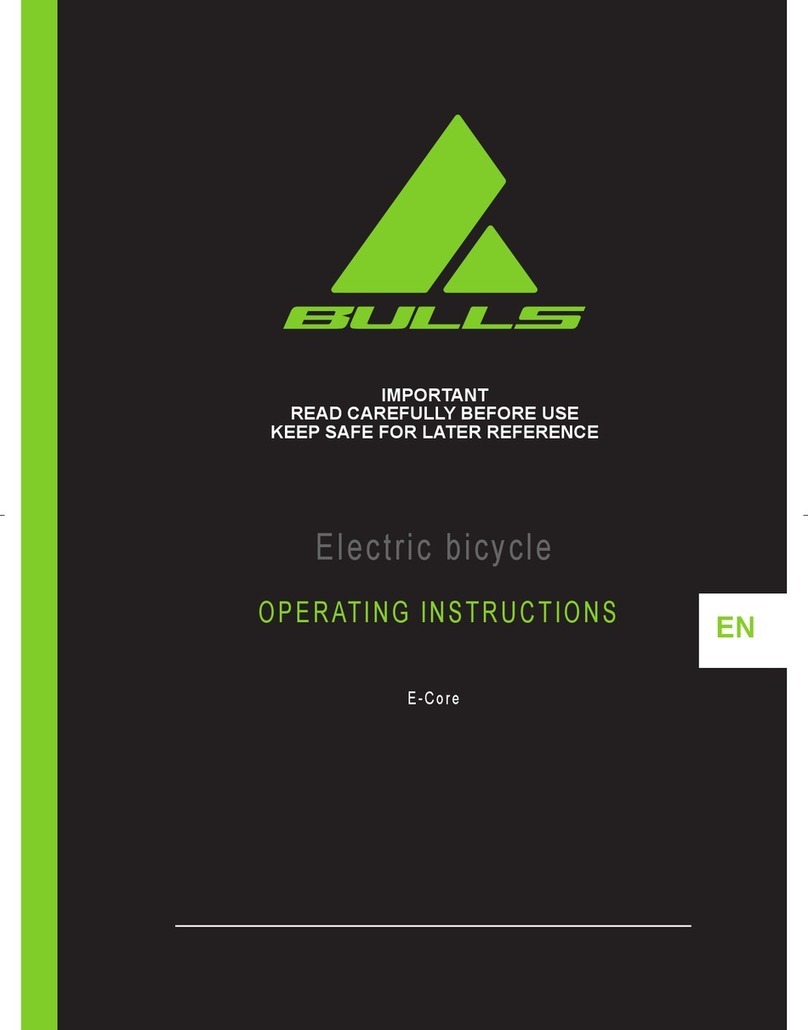
Bulls
Bulls E-Core Series operating instructions
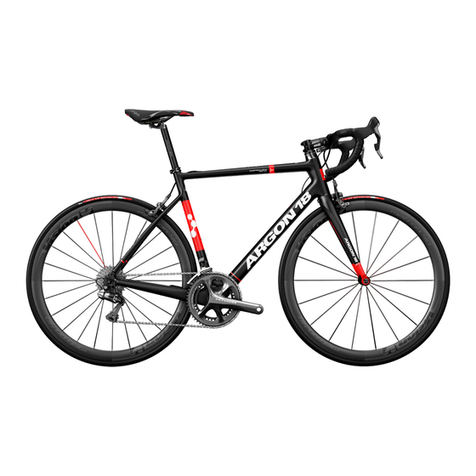
ARGON18
ARGON18 KRYPTON 212A Assembly guide
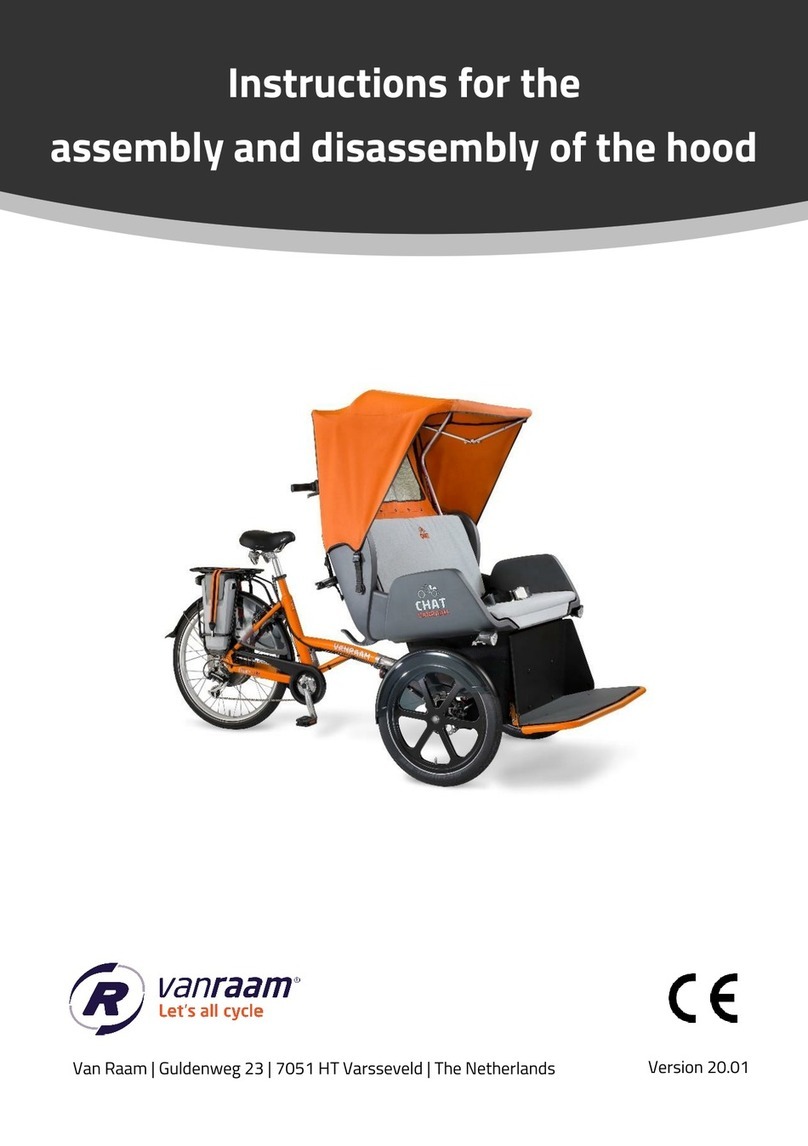
Vanraam
Vanraam Chat Instructions for the assembly and disassembly of the hood
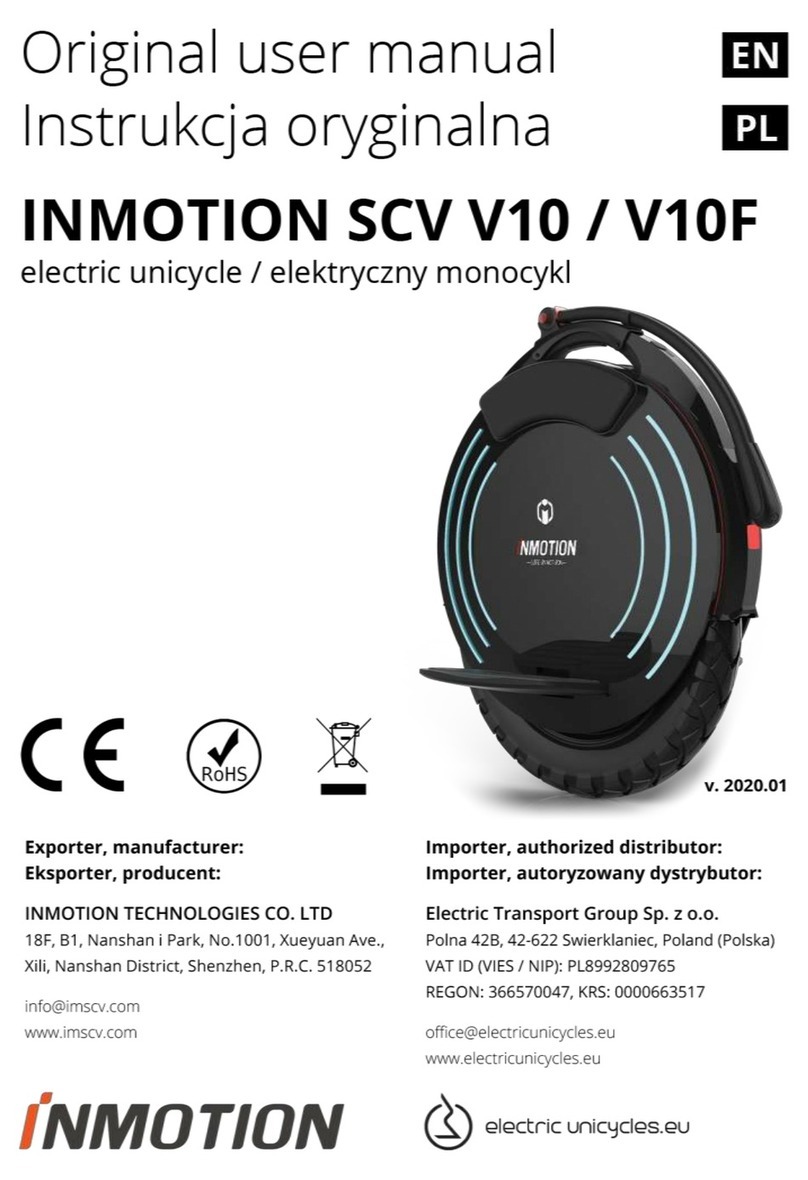
InMotion
InMotion SCV V10 Series Original user manual

Xtreme
Xtreme XB-300Li owner's manual
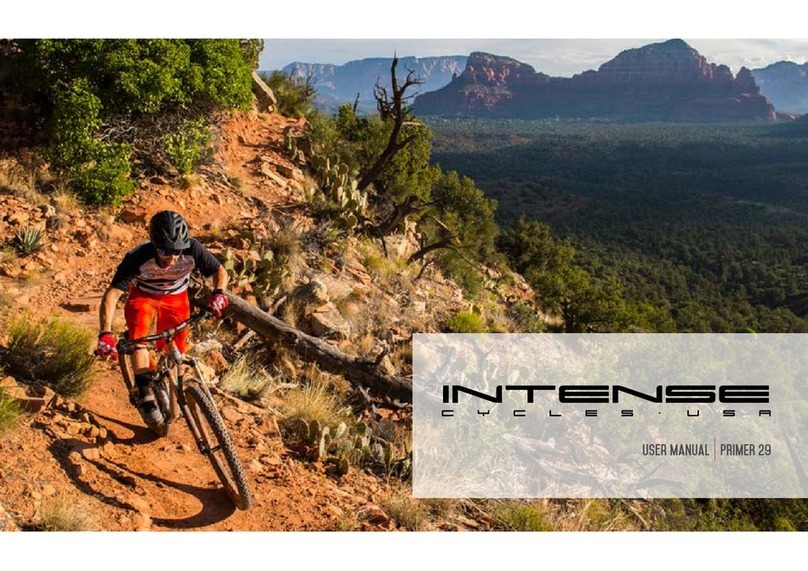
INTENSEcycles
INTENSEcycles PRIMER 29 user manual

